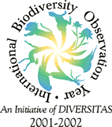 International Biodiversity Observation Year (IBOY) is an initiative of
DIVERSITAS, the international program on biodiversity science, and will be
launched on December 29, 2000, the United Nations International Day for
Biological Diversity.
International Biodiversity Observation Year (IBOY) is an initiative of
DIVERSITAS, the international program on biodiversity science, and will be
launched on December 29, 2000, the United Nations International Day for
Biological Diversity.
A year to focus global attention on biodiversity and the sciences that
explore it is being planned for 2001- 2002 (Norris, 2000). The
 International Biodiversity Observation Year (IBOY) is an initiative of
DIVERSITAS, the international program on biodiversity science, and will be
launched on December 29, 2000, the United Nations International Day for
Biological Diversity.
International Biodiversity Observation Year (IBOY) is an initiative of
DIVERSITAS, the international program on biodiversity science, and will be
launched on December 29, 2000, the United Nations International Day for
Biological Diversity.
The IBOY is a window in time for programs that examine biodiversity and its links to ecosystems and society to communicate their findings and the importance of their work to a broad audience. Organizers hope that IBOY will advance international and integrated approaches to biodiversity conservation. For example, promoting coordinated, long-term, international biodiversity monitoring programs and new coalitions for swifter incorporation of scientific findings into the media, education and decision-making.
Planning for the IBOY began in 1997, in response to a growing awareness among the scientific community that accurate and timely information on the extent and significance of biodiversity loss was not being communicated to the public. Simultaneously, the need to integrate the different dimensions of biodiversity research was recognized, to better understand relationships between biodiversity, ecosystems, global change and society..
An international Steering Committee, chaired by Diana Wall, and an Advisory Board of preeminent scientists and communicators, is directing IBOY towards its two primary goals, to:
Core projects: Projects with an international scope, and a peak of activity and products during 2001 - 2002. The IBOY will showcase these projects, highlighting the importance of the biodiversity information they deliver. It will provide a platform for exchanging ideas and information between projects, stimulating research and developing new mechanisms for integrating and disseminating this knowledge.To date 35 international ‘core’ projects, across more than 50 countries are preparing to participate in the IBOY. They fall into 3 categories:Linked projects: If projects are not international, or are otherwise not suited to participate in the IBOY as a core project, IBOY can still publicize them. For example, in a global catalog of research, education and media projects, that will be accessible from the IBOY website.
Synthesis activities, including meetings, webpages, publications, festivals and films, are being planned for the IBOY that will draw projects and communities together to:
We welcome your suggestions for making the IBOY a global success. More
information on the IBOY, its projects, and how to get involved can be found
from the
IBOY webpage or by contacting
Dr. Gina AdamsReferences:
IBOY Program Officer
Natural Resource Ecology Laboratory
Colorado State University
Fort Collins, CO 80523-1499
USA. Tel: +1 970 491 1984
Fax: +1 970 491 3945
email iboy@nrel.colostate.edu